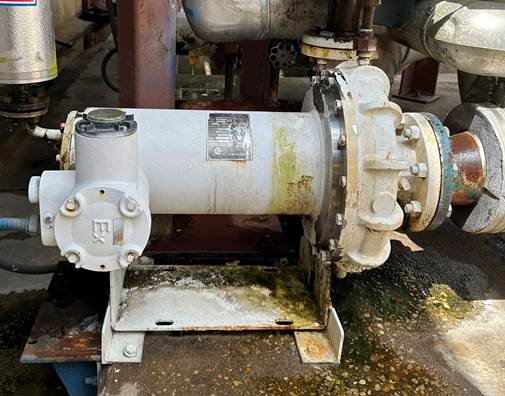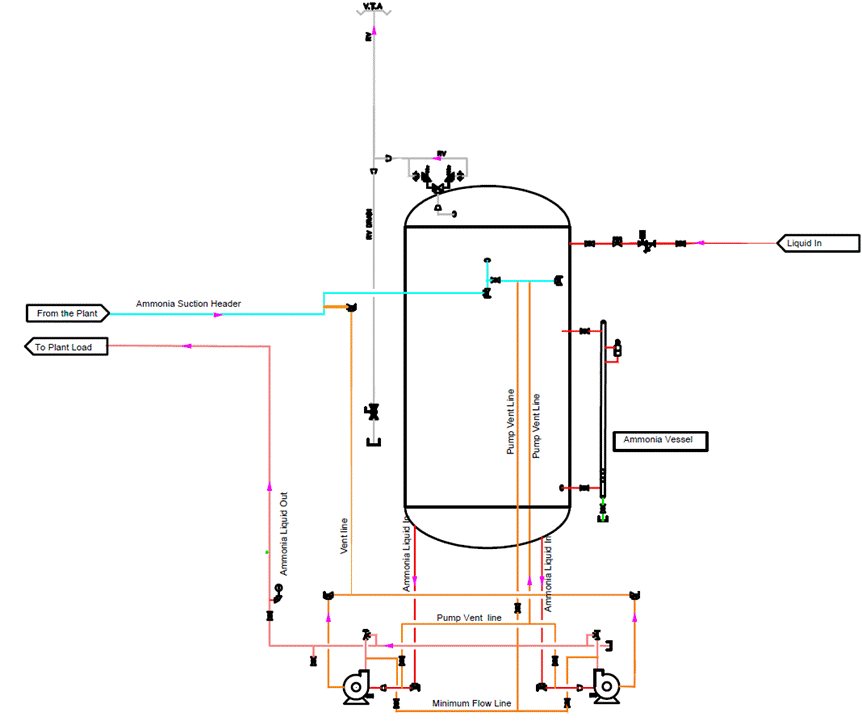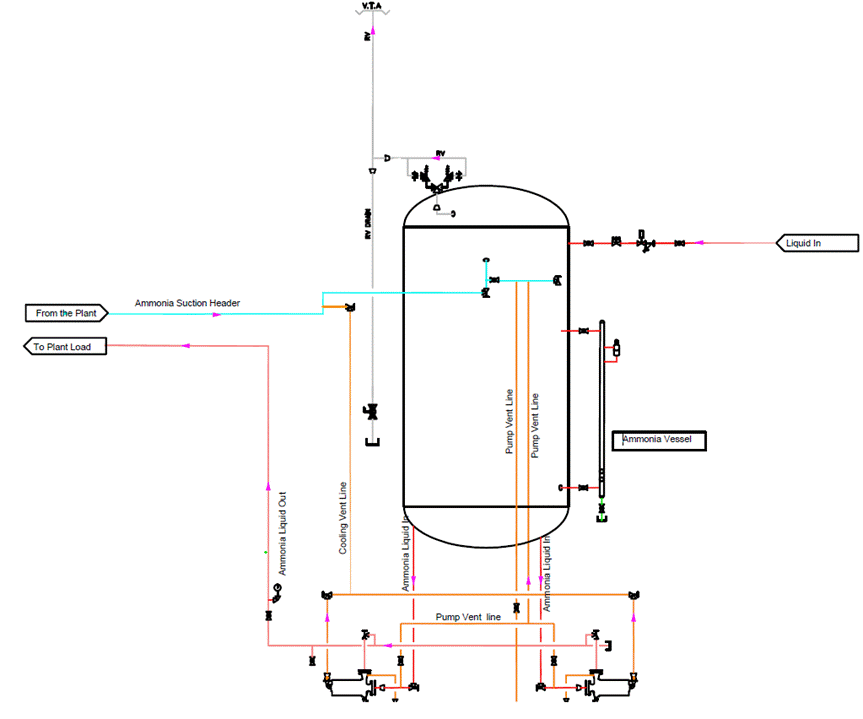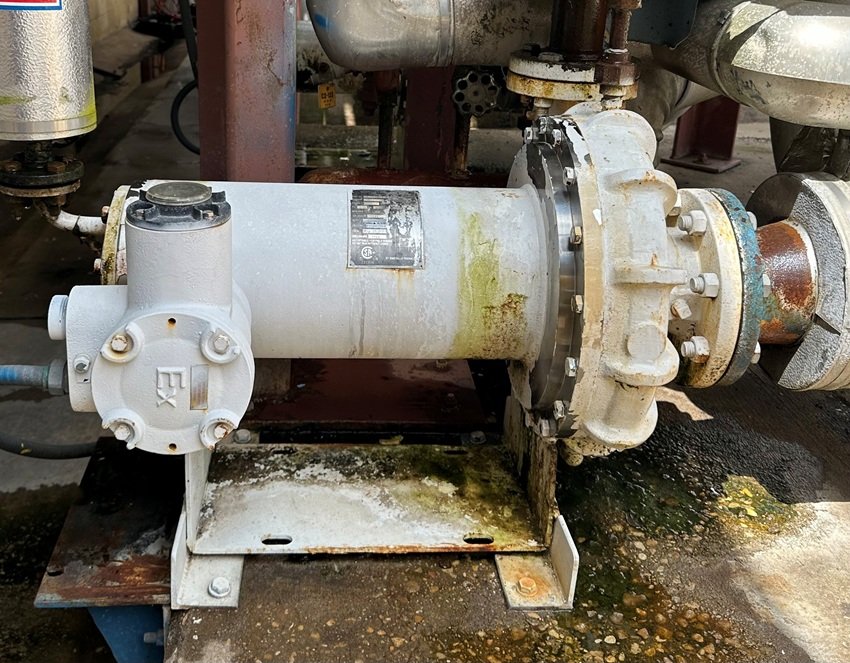Mitigating Liquid Trapping Risks in Ammonia Recirculation Pump Systems
In industrial ammonia refrigeration systems, pumps play a vital role in circulating liquid ammonia to maintain cooling efficiency across evaporators and heat exchangers. The choice of pump type directly impacts system reliability, safety, and maintenance requirements. Among the most common options are conventional (mechanical seal) pumps and sealed (hermetic) pumps. Understanding their differences helps refrigeration professionals select the right technology for their facility. These pumps, often installed in parallel for redundancy, are the backbone of industrial cold storage and food processing facilities.
While their role in process continuity is well understood, a less obvious but critical hazard exists: liquid trapping in the pump casing when suction and discharge valves are closed. If unaddressed, this condition can lead to dangerous hydrostatic overpressure, creating both a safety hazard and regulatory non-compliance. This article compares two common pumps piping arrangements conventional pump piping design and sealed pump piping designs - with a focus on their implications for liquid trapping and process safety.
Conventional Ammonia Pumps
Conventional pumps are designed and operate using a mechanical shaft seal where the shaft penetrates the pump casing to connect with the motor. The seal prevents ammonia leakage while allowing the shaft to rotate at high speeds. Pumps are typically close-coupled or base-mounted, with lubrication requirements to ensure seal longevity. The great advantage of these conventional pumps is they are proven, time-tested design with wide industry adoption. They have readily available spare parts and service expertise. These pumps also offer lower initial cost compared to hermetic options along with flexibility in motor selection and replacement. The commonly known issues are the mechanical seal being a wear point and potential source of ammonia leaks. They also require routine monitoring for seal condition, lubrication, and vibration. These pumps also required periodic maintenance and could lead to unplanned downtime. There is a risk of potential ammonia release around seal faces in case of seal failure.
Sealed (Hermetic) Ammonia Pumps
In sealed pumps, the motor and pump are enclosed within a common welded housing. The motor operates submerged in liquid ammonia, with no external shaft or mechanical seal. Cooling and lubrication come directly from the pumped refrigerant. The biggest advantage of these sealed pump is there are no shaft seals, virtually eliminates seal leakage risk. Hermetic sealed pumps deliver long term cost efficiency through reduced maintenance and minimal spare part needs, while their compact design improves system layout and enhances safety by minimizing mechanical failure risks. Some of the challenges are they are higher upfront cost compared to conventional pumps. They require specialized service expertise for repair (often factory return). If motor fails, the entire unit may need replacement rather than just seal repair. Potentially less flexible in motor options and availability compared to conventional design.
|
Feature |
Conventional Pump |
Sealed (Hermetic) Pump |
|---|---|---|
|
Seal Type |
Mechanical shaft seal |
No seal (hermetic enclosure) |
|
Leak Potential |
Moderate to high (seal wear) |
Very low (no shaft penetration) |
|
Maintenance |
Frequent seal inspection/replacement |
Minimal, longer service intervals |
|
Safety |
Requires monitoring for leaks |
Safer, reduced ammonia emissions |
|
Initial Cost |
Lower |
Higher |
|
Repair ability |
Field repairable |
Often factory repair or replacement |
|
Service Life |
Shorter due to seal wear |
Longer due to sealed design |

Figure 1: Sealed ammonia pump
One of the recurring issues that I experienced with conventional mechanical seal pumps used to circulate ammonia to our blast freezers was with the seal failure. The mechanical seals are prone to premature wear due to pressure fluctuations and vibration in the piping network, leading to small but frequent ammonia leaks. These failures lead to potential safety risks and production downtime. Safety risk as operators had to repeatedly respond to ammonia detectors triggering in the pump room. Downtime as every seal replacement required shutting down part of the refrigeration system, affecting production cooling requirements leading to unscheduled downtimes.
By replacing the conventional pumps with hermetic sealed pumps, the facility achieved:
- Zero shaft-seal leakage, improving operator safety.
- Reduced downtime - no more recurring seal maintenance, improving freezer uptime and reliability.
- Regulatory compliance improvement - significant reduction in ammonia leak reporting.
- Lifecycle cost savings – although the hermetic pumps were more expensive initially, they paid for themselves within two years by reducing maintenance labor and unplanned downtime.
This change was a turning point in the plant’s process safety program, demonstrating how equipment upgrades can directly support PSM, environmental compliance, and operational efficiency. Based on the market research, many facilities are transitioning to sealed pumps due to heightened focus on safety, environmental regulations, and sustainability goals. However, conventional pumps remain widely used, especially in older installations where cost and familiarity drive decisions. In mission-critical food and beverage operations, sealed pumps are increasingly preferred to reduce risk of ammonia release.
The Hazard of Trapped Liquid
Liquid ammonia, like all liquids, is virtually incompressible. If confined in a closed system volume, even a small temperature increase can cause a disproportionate rise in pressure. Hydrostatic Expansion Effect: Ammonia trapped in a pump casing can see pressures skyrocket well above 1,000 psig with only modest temperature increases if no relief path exists. Such a scenario can rupture pump casings, damage piping, and release large quantities of ammonia into the environment leading a major safety and regulatory incident. Thus, avoiding liquid trapping in pump systems is not just good engineering.
Conventional pump piping Design
Historically, pump casings have been equipped with manual vent lines connected back to the surge drum. The primary purpose of these vents is designed for startup, allowing operators to purge vapor and ensure the pump is fully primed with liquid ammonia. In normal operation, these vents are usually closed. If suction and discharge isolation valves are also closed, the pump casing becomes a completely trapped liquid volume. This design requires either strict operating discipline (vent opened before shutdown) or the addition of a dedicated hydrostatic relief valve to remain compliant with RAGAGEP and OSHA PSM requirements.

Figure 2: Conventional ammonia pump piping
Sealed Pump Piping Design
Hermetic or canned-motor recirculation pumps adopt cooling return lines. They provide cooling flow for pump motors and bearings. Also, act as a continuous bleed path from the pump casing back to the wet suction header. Since these return lines are normally open and non-operator dependent, they inherently prevent the pump casing from becoming a trapped liquid volume. This makes the cooling return design more robust from a PSM standpoint, as it eliminates the need for separate hydrostatic reliefs and reduces reliance on human action.

Figure 3: Sealed ammonia pump with cooling Vent Line
Comparative Analysis
|
Feature |
Conventional Pump piping design |
Sealed pump piping design |
|---|---|---|
|
Relief Path |
Manual vent, operator-controlled |
Continuous, automatic return |
|
Risk of Liquid Trap |
High if vent shut + suction/discharge closed |
Very low, casing cannot be fully trapped |
|
Operator Dependence |
High |
Low |
|
Compliance Needs |
Hydrostatic relief valves recommended |
Inherently safer, aligned with RAGAGEP |
Best Practices for Facilities
-
Evaluate Existing Pump Designs: Identify systems with vent-only arrangements and assess if hydrostatic relief valves are installed.
-
Operator Training: Emphasize the importance of venting before pump shutdown in conventional designs.
-
Upgrade Path: Where feasible, consider transitioning to sealed pumps that provide built-in protection against liquid trapping.
-
Never Isolate Cooling Returns: For systems with cooling return lines, ensure procedures prohibit closing these lines under any circumstances.
Conclusion
Both conventional and sealed ammonia pumps have a place in industrial refrigeration. While conventional pumps offer proven reliability and lower initial costs, they require ongoing attention to seals and pose higher leakage risks. Sealed pumps, though more expensive upfront, enhance safety, reduce emissions, and simplify maintenance. In real-world operations, upgrading from conventional to sealed pumps has solved critical problems - minimizing ammonia leaks, ensuring regulatory compliance, and improving system uptime.
The evolution from conventional pump piping design to sealed pump piping design represents a significant step forward in ammonia refrigeration safety. While both designs serve the purpose of keeping pumps primed, only the cooling return configuration provides a continuous safeguard against liquid trapping and hydrostatic overpressure. From a Process Safety Management perspective, the cooling return design is inherently safer, less operator-dependent, and more consistent with modern RAGAGEP. For facilities operating ammonia refrigeration systems, recognizing this difference and applying best practices can significantly reduce the risk of catastrophic pump failures and drive long term efficiency.Author

Kushal Aurangabadkar
Cargill Inc
Engineering Manager
